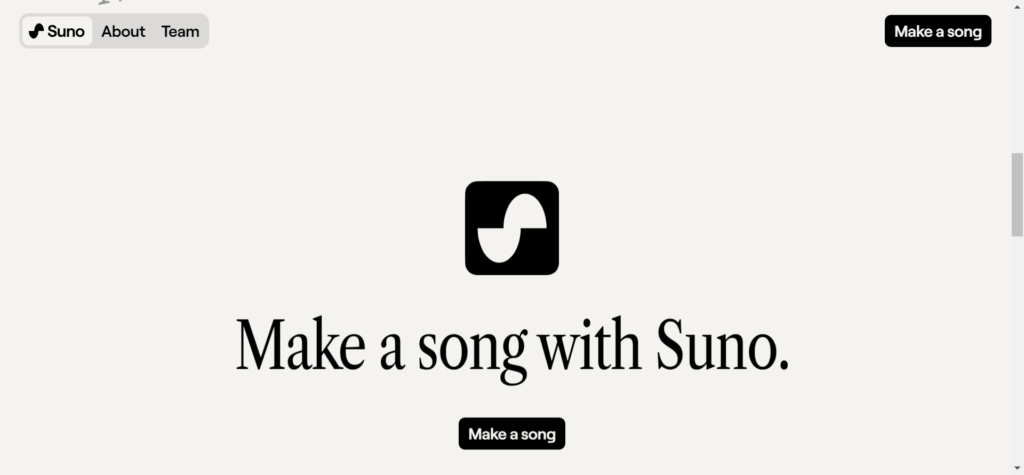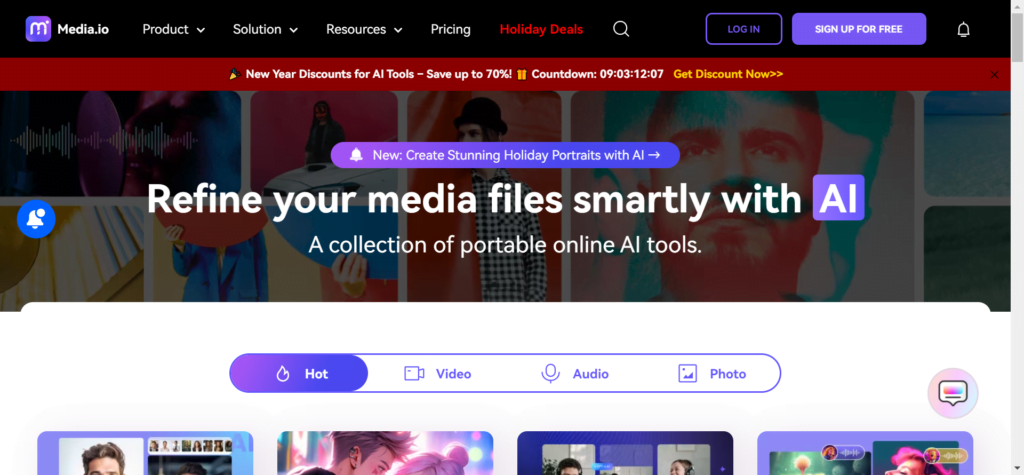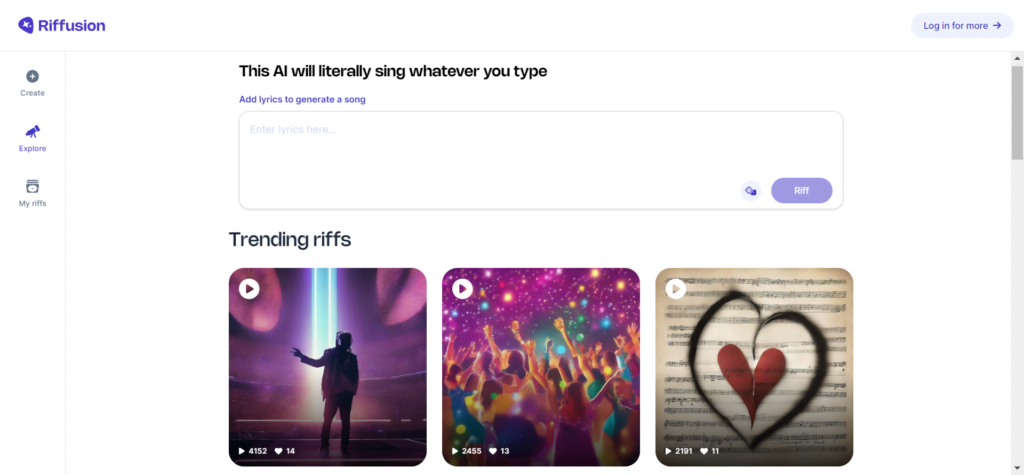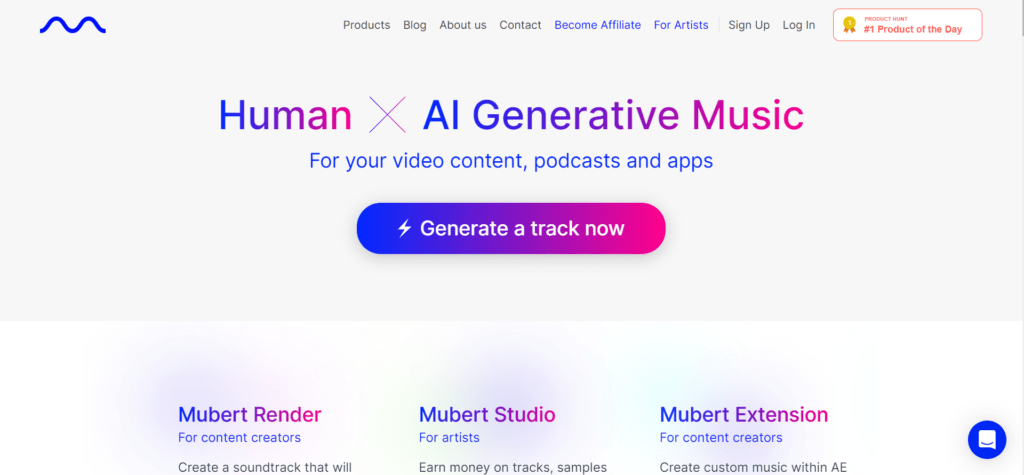Have you ever stared at a blank page, the melody in your head mocking your inability to translate it into words? Or maybe writer’s block has you tangled in a web of cliches, desperately seeking a fresh spark of creativity? Fear not, fellow music makers, for a new era has dawned, one where artificial intelligence stands ready to be your songwriting muse. Yes, we’re talking about AI music generators, and they’re not just here to play backup – they’re ready to take your songwriting game to the next level.
But with so many options floating around in the digital ether, where do you start? Fear not, intrepid troublemakers, because I’ve scoured the sonic landscape to bring you the 5 best free AI music generators for lyrics and songwriting in 2024. Consider this your roadmap to uncovering your inner songstress, one AI-powered verse at a time.
1. Sunoai
Sunoi’s name is derived from the Japanese word for “honesty” and it aims to live up to this by offering genuine musical creation through artificial intelligence. It’s more than just a song generator; It’s a platform designed to spark your musical imagination and guide you in the creative process, regardless of your experience level.

Strength:
- Genre Diversity: Sunoi has a huge library of music genres ranging from classical and jazz to electronic and pop. You can choose from pre-defined styles or even fine-tune your preferences by adjusting the mood, tempo, and instrumentation.
- User-friendly interface: Sunoi’s interface is intuitive and visually appealing, even for those unfamiliar with music production. You can drag and drop musical elements, experiment with different sections, and easily adjust parameters like key and time signature.
- Collaboration and sharing: Sunoi allows real-time collaboration with other musicians, even remotely. You can invite your friends or fellow creators to contribute your songs and start your musical journey together. Sharing your creations is also easy, with options to export finished tracks or embed them on websites.
- Advanced Features: For experienced musicians, Sunoi offers advanced tools like MIDI export, chord editing, and detailed waveform editing. This level of control lets you refine your AI-generated track to perfectly match your artistic vision.
Weaknesses:
- Learning curve: While Sunoi is beginner-friendly, it may require some exploration and experimentation to master its full potential. The sheer number of options and settings may seem overwhelming at first.
- AI algorithm bias: Like many AI tools, Sunoi’s music generation can sometimes lean toward predictable patterns or genre clichés. It is necessary to actively guide the AI with your preferences and creative input to avoid generic outcomes.
- Limited commercial use: Although personal and educational use is encouraged, Sunoi currently has restrictions on commercial applications of the music you create. Be sure to check their terms of use before incorporating your AI-powered creations into professional projects.
Unique features:
- Musical Storyboarding: Sunoi’s “Scorebuilder” feature allows you to create visual storyboards for your music, outlining the emotional arc and key moments of your song. This helps guide the AI and adds a unique layer of creative control.
- AI Performance Assistant: Sunoi can also “play” your generated music using virtual instruments, providing a real-time preview of your composition and a potential starting point for further development.
- Community and Resources: Sunoi fosters a vibrant community of musicians and users, providing tutorials, workshops, and a feedback forum to help you get the most from the platform.
Overall, Sunoi is a powerful and versatile tool for musicians of all levels. Its strength lies in its user-friendly interface, style variety, and collaborative features. While some learning curve and potential AI bias exist, Sunoi’s unique features and commitment to user support make it an attractive option for anyone wanting to explore the creative potential of AI music generation.
2. Media io
While Media.io isn’t solely focused on music creation, its AI-powered tool called “Melody Maker” guarantees exploration in the context of your list. Here are details of its strengths, weaknesses, and unique features:

Strength:
- Simplicity and Integration: Melody Maker integrates seamlessly into Media.io’s video editing platform, making it an accessible option for creators accustomed to video production. No complicated setup or additional software is required.
- Intuitive interface: Similar to Sunoi, Melody Maker boasts a user-friendly interface with drag-and-drop functionality. Users can easily customize parameters like style, mood, and duration.
- Royalty-Free Music: All music generated through Melody Maker is royalty-free, allowing creators to use it in their videos without copyright concerns. This is a significant advantage for video production projects.
- Additional Features: Beyond music creation, Melody Maker offers basic audio editing tools like trimming and fade-in/out, which further enhances its integration with video editing workflows.
Weaknesses:
- Limited music depth: Compared to dedicated music AI tools like Sunoi and MuseNet, Melody Maker’s music creation capabilities are somewhat shallow. Its focus is on providing functional background music for videos, which lacks the depth and complexity for standalone musical exploration.
- Genre Focus: Offering a variety of mood options, Melody Maker’s pre-set genres lean toward more general categories like “action,” “romance,” and “comedy.” If you’re looking for specific musical genres or complex instruments, other AI tools may be more suitable.
- Customization Constraints: Compared to Sunoi’s advanced parameter controls, Melody Maker’s customization options are more limited. You can fine-tune the mood and duration, but detailed control over key, tempo, or individual instruments is missing.
Unique features:
- Video Synchronization: Melody Maker allows direct synchronization of the generated music with your video editing timeline. This makes it easier to match the tempo and mood of the music with specific video scenes.
- Sound Effects Integration: Beyond background music, Melody Maker offers a library of royalty-free sound effects, further enhancing your video production capabilities within the platform.
- Freemium Model: Media.io offers a free version of Melody Maker with limited features. Upgrading to a paid plan unlocks additional music genres, extended duration options, and higher quality output.
Overall:
Melody Maker is a valuable tool for video creators who want to easily add royalty-free music to their projects. Its user-friendly interface, tight video integration, and additional sound effects make it a convenient one-stop shop for audio needs. However, if you seek deeper musical exploration or aim to create standalone music compositions, dedicated AI music generation platforms like Sunoai or MuseNet might be better suited for your creative goals.
3. Veed.io
Veed.io is a versatile tool that has transcended its video editing roots to embrace the world of AI music generation with its jukebox feature. Let’s look at its strengths, weaknesses, and unique points to assess its place in your AI music generator lineup.

Strength:
- Genre Chameleon: Jukebox boasts an impressive range of musical styles, imitating established artists and even mixing genres for surprising sonic cocktails. Think anything from blues ballads sung by Johnny Cash to pulsating EDM anthems in the style of your favorite DJ.
- Collaboration capabilities: Veed.io allows real-time collaboration on video, but Jukebox takes it a step further. You can collaborate on music creation with teammates or friends, incorporating new ideas and refining your compositions together.
- Integration and ease of use: Jukebox easily integrates with Veed.io’s video editing interface, making it easy to add the generated music directly to your project. This creates a seamless workflow for video creators looking for sound accompaniment.
- Royalty-free music: Like Media.io’s Melody Maker, all music generated with Jukebox is royalty-free, ensuring you can use it in your projects without copyright hassles.
Weaknesses:
- Control Limitations: Compared to Sunoi and MuseNet, Jukebox offers less parameter control. You can choose the genres and artists to inspire it, but it’s not possible to fine-tune the key, tempo, or individual instruments. This may limit the musical depth of dedicated musicians.
- Predictability Tendencies: Like other AI music tools, Jukebox may lean toward predictable patterns or clichés within its chosen genres. Experimentation and providing specific indications are important to avoid general consequences.
- Video-centric focus: While Jukebox allows standalone music export, its primary purpose is integration with video projects. It may not be ideal for those interested only in music composition without video editing context.
Unique features:
- Remixing possibilities: Jukebox allows you to remix existing music clips, adding a unique twist to familiar tunes. This opens up creative possibilities for mashups, reinterpretations, and unexpected sonic experiments.
- AI Vocal Mimicry: Jukebox can also mimic the vocal styles of specific artists, adding a personalized touch to your project. Imagine a song with lyrics in your voice but sung by your musical idol!
- Community and Resources: Veed.io provides a supportive community and helpful resources on using the Jukebox effectively. From tutorials to user forums, you can find guidance and inspiration to unlock the full potential of this AI music tool.
Overall:
Veed.io’s Jukebox is a versatile tool for video creators and music lovers looking for a user-friendly way to add unique and royalty-free music to their projects. Its genre-bending capabilities, collaboration features, and remixing possibilities provide creative fuel for a variety of applications. However, its range in fine-tuning parameters and video-centric focus may not be ideal for musicians wanting deeper control or standalone music composition.
4. Riffusion
Refusion is not your typical AI music generator. It rules out pre-defined styles and artist imitations, instead opting for a purely text-based approach. Let’s see how this unique instrument creates a sonic landscape from a mere description:

Strength:
- Unleash your imagination: Refusion lets you paint sonic landscapes with words. Describe mood, texture, instruments, or even specific musical elements, and it creates a unique piece based on your textual brushstrokes. This provides immense creative freedom, allowing you to create music that is different from what you have heard before.
- Experimental Playground: With Refusion, there are no genre boundaries. Do you want a mix of baroque harpsichord and futuristic synth drones? describe it! Feeling like a jazzy tango with theremin solos? Refusion is your sonic chemist. This experimental spirit pushes musical boundaries and encourages bold explorations.
- Refine and Iterate: Refusion doesn’t offer just a one-shot. You can give feedback, adjust your details, and create new versions, refining your composition until it perfectly matches your sonic vision. This iterative process allows you to sculpt the music like digital clay, ensuring a truly personalized result.
- Open Source Foundation: Unlike some proprietary AI tools, Refusion’s code is open-source, meaning anyone can contribute to its development and improve its capabilities. This transparency fosters a collaborative spirit and fosters innovation within the AI music generation community.
Weaknesses:
- Learning curve: Mastering the art of describing music with words can be a challenge. Understanding how Refusal interprets your signals and refining your descriptions takes practice. New users may experience some initial trial and error before their sonic vision is realized.
- Unpredictability: With such unlimited freedom comes inherent unpredictability. Refusion doesn’t always translate your details exactly as you envision, leading to unexpected twists and turns in your sonic journey. This can be both a blessing (creative surprises) and a curse (unwanted twists).
- Technical Barriers: Refusion is a web-based application currently in the early stages of development. Access may require joining a waiting list, and some technical glitches may be encountered. Patience and understanding are important as this promising device continues to be developed.
Unique features:
- Collaborative creation: Refusion allows multiple users to work together on the same musical piece, adding their textual details and shaping the music together. This real-time collaboration opens the way for collective sonic storytelling and shared creative adventures.
- Community and Exploration: Refusion fosters a vibrant community of musicians, artists, and AI enthusiasts who share their creations, tips, and feedback. This collaborative spirit helps users navigate the tool’s learning curve and discover its vast potential.
- Beyond music: Refusion’s text-based approach has potential beyond music. Imagine generating sound effects for games, ambient sound landscapes for meditation, or even personalized audio branding based on textual descriptions. The possibilities of this instrument extend far beyond traditional tunes and notes.
Overall:
Refusion is a leader in the world of text-based AI music generation. It empowers users to sculpt sound with words, providing unparalleled creative freedom and limitless sonic possibilities. Although its learning curve and unpredictable nature can create challenges, its open-source foundation, collaborative features, and experimental spirit make it an attractive tool for adventurous music makers and curious explorers of the world of sound-shaping.
5. Mubert
Unlike the other generators you mentioned, Mubert’s goal isn’t to create catchy pop anthems or genre-bending masterpieces. Mubert specializes in a unique field: generative ambient music. So, if you are looking for calm, meditative sound landscapes to concentrate, relax, or sleep, Mubert could be your ideal AI musical companion.

Strength:
- Focus on relaxation and well-being: Mubert’s music prioritizes peaceful soundscapes, using textures, drones, and subtle melodies to create a sense of calm and focus. This makes it ideal for studying, yoga, meditation or just relaxing after a long day.
- Customization and Controls: While Mubert doesn’t offer genre selection or specific instrument controls, it does allow you to personalize your listening experience in other ways. Adjust the “Focus” level for intense concentration or deep relaxation, choose from different moods like “Calm” or “Energetic” and even set a timer for customized listening sessions.
- AI Adaptability: Mubert’s AI learns your preferences over time, tailoring the generated sound scenarios to your specific needs and reactions. The more you listen, the better it understands what helps you relax and focus, creating a personalized soundscape experience.
- Offline listening: Unlike some AI music generators, Mubert does not require a constant internet connection. Download your favorite soundscapes for offline listening, making it perfect for traveling, camping or any situation where Internet access may be limited.
Weaknesses:
- Limited musical range: Compared to other AI generators, Mubert’s range is narrow. If you’re looking for dynamic melodies, catchy rhythms, or specific musical styles, this may not be the best choice for you. Its focus is entirely on ambient soundscapes and relaxation.
- Repetitive tendencies: Like any AI tool, Mubert’s algorithms can sometimes fall into repetitive patterns. Although the music is designed to be calm and predictable, some users may find it overly monotonous after listening for a long time.
- Pricing Model: Mubert offers a free trial, but requires a paid subscription to access its full features. This may be a deterrent for some users who prefer free or outright purchase options for their AI music tools.
Unique features:
- Brainwave Entrainment: Mubert incorporates subtle binaural beats designed to sync with your brain waves and induce specific states of focus, relaxation or sleep. This adds a layer of neurotechnology to the listening experience, potentially enhancing its wellness benefits.
- Curated Collection: Mubert offers a curated collection of sound scenarios for different situations and purposes, from focus playlists to sleep-inducing mixes. It offers pre-built options for users who don’t want to get into customization.
- Community and Inspiration: Mubert fosters a supportive community of users who share their experiences and tips to get the most out of the platform. This community creates a sense of collective well-being and can inspire new ways of using Maubert’s sound landscapes.
Overall:
Mubert is a unique AI music tool for those seeking tranquility and focus through ambient soundscapes. Its strengths lie in its customizable relaxation features, AI adaptability, and offline listening options. While its musical scope is limited and repetitive tendencies might emerge, its focus on well-being and integration of brainwave entrainment technology makes it a compelling option for anyone seeking calm and concentration in their daily lives.
nleashing Your Inner Bard: A Symphony of AI Musical Possibilities
The future of music no longer rests solely in the hands of human composers. AI music generation has arrived, offering a revolutionary toolbox for musicians, creators, and anyone who dreams of shaping sound into something personal and powerful. Whether you yearn for catchy pop hooks, genre-bending sonic explosions, or calming ambient landscapes, the five AI tools explored here present a diverse, accessible, and ever-evolving landscape for creative expression.
Sunoai stands as your AI muse, guiding you through diverse musical styles and collaborating on your sonic adventures. Media.io’s Melody Maker offers royalty-free background music for seamless video integration, while Veed.io’s Jukebox lets you remix reality and mimic musical idols, adding a playful twist to your projects. Riffusion invites you to paint soundscapes with words, pushing boundaries and embracing the unpredictable in a purely text-based approach. And for those seeking tranquil solace, Mubert becomes your AI companion, weaving personalized ambient tapestries for focus, relaxation, and mindful exploration.
But remember the true tune lies in your vision. These tools are tools, not replacements. Embrace their possibilities, experiment and add your own creative spark. The future of music does not belong to AI alone, but to the harmonious collaboration between human imagination and technological innovation. So, pick up your virtual baton, immerse yourself in the symphony of AI, and unleash the music that lives within you.
FAQs
Q: Can AI write a hit song?
A: While AI can generate catchy melodies and clever lyrics, creating a true hit involves much more than technical skill. Understanding audience preferences, industry trends and a touch of serendipity still plays an important role. However, AI can undoubtedly be a valuable tool for songwriting, increasing the chances of creating a song with hit potential.
Q: Will AI replace human songwriters?
A: No, AI is here to empower human songwriters, not replace them. By taking care of technical aspects like music production and arrangement, AI frees up human creativity to focus on the emotional core of music, leading to a more authentic and impactful creative process.
Q: Is it ethical to use AI for music production?
A: The ethical implications of AI music creation are complex and worthy of open discussion. However, as long as AI is used transparently and respectfully, and as long as human creativity remains at the center of the music-making process, it can be a valuable tool for artistic expression.
Q: What are the limitations of AI music generators?
A: Current AI music generators can sometimes fall into predictable patterns or lack the depth and complexity of human-composed music. Additionally, relying solely on AI may limit your creative growth and stifle your unique artistic voice.
Q: How can I learn more about using AI for songwriting?
A: Many online resources, tutorials, and communities exist dedicated to AI music creation. Explore these resources, experiment with different AI tools and connect with other creators to learn, share, and grow in this exciting new area of music creation.

Your point of view caught my eye and was very interesting. Thanks. I have a question for you.
I’m glad you found my perspective interesting! Absolutely, fire away with your question. I’m happy to discuss it further.